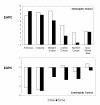Worldwide trends in mortality from biliary tract malignancies
- PMID: 11991810
- PMCID: PMC113759
- DOI: 10.1186/1471-2407-2-10
Worldwide trends in mortality from biliary tract malignancies
Abstract
Background: Intrahepatic cholangiocarcinomas are malignant tumors arising from the intrahepatic biliary tract. The pathogenesis of these tumors remains unknown. Although there is a marked global variation in prevalence, some recent studies have suggested an increase in mortality from intrahepatic cholangiocarcinoma in several regions of low endemicity. As the study of mortality trends may yield clues to possible etiological factors, we analyzed worldwide time trends in mortality from biliary tract malignancies.
Methods: Annual age-standardized rates for individual countries were compiled for deaths from biliary tract malignancies using the WHO database. These data were used to analyze gender and site-specific trends in mortality rates.
Results: An increasing trend for mortality from intrahepatic cholangiocarcinoma was noted in most countries. The average estimated annual percentage change (EAPC) in mortality rates for males was 6.9 +/- 1.5, and for females was 5.1 +/- 1.0. Increased mortality rates were observed in all geographic regions. Within Europe, increases were higher in Western Europe than in Central or Northern Europe. In contrast, mortality rates for extrahepatic biliary tract malignancies showed a decreasing trend in most countries, with an overall average EAPC of -0.3 +/- 0.4 for males, but -1.3 +/- 0.4 for females.
Conclusions: There has been a marked global increase in mortality from intrahepatic, but not extra-hepatic, biliary tract malignancies.
Figures
References
-
- Green A, Uttaravichien T, Bhudhisawasdi V, Chartbanchachai W, Elkins DB, Marieng EO, et al. Cholangiocarcinoma in north east Thailand. A hospital-based study. Trop Geogr Med. 1991;43:193–8. - PubMed
-
- Haswell-Elkins MR, Mairiang E, Mairiang P, Chaiyakum J, Chamadol N, Loapaiboon V, et al. Cross-sectional study of Opisthorchis viverrini infection and cholangiocarcinoma in communities within a high-risk area in northeast Thailand. Int J Cancer. 1994;59:505–9. - PubMed
-
- Flavell DJ. Liver-fluke infection as an aetiological factor in bile-duct carcinoma of man. Trans R Soc Trop Med Hyg. 1981;75:814–24. - PubMed
-
- Parkin DM, Ohshima H, Srivatanakul P, Vatanasapt V. Cholangiocarcinoma: epidemiology, mechanisms of carcinogenesis and prevention. Cancer Epidemiol Biomarkers Prev. 1993;2:537–44. - PubMed
Publication types
MeSH terms
Grants and funding
LinkOut - more resources
Full Text Sources
Other Literature Sources
Medical
Research Materials


